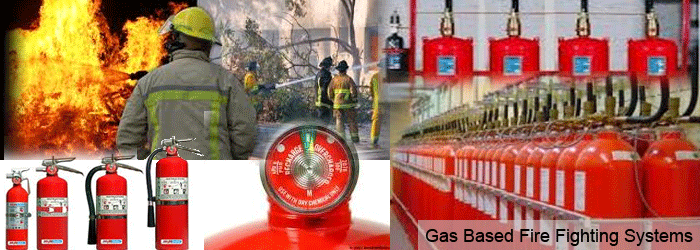| Specilazations |
|
|
|
|
Gas Based Fire Fighting Systems |
Co2 Gas Flooding Systems::
Gas flooding technologies primarily use carbon dioxide flooding as a method to fire by channeling gas into afected areas. CO2 flooding technologies experiment with a number of foams, gels, and thickening agents to improve sweep efficiency. CO2 floods are extensively used in all areas., particularly in industries and corporate houses. In the past decade flooding with nitrogen gas, flue gas, and enriched natural gas have also shown some beneficial results by increasing recovery when used to re-pressure reservoirs. Nitrogen and flue gas may be useful in areas where CO2 is not economically available for use.In addition to fire detection and alarm systems, organizations that have a dedicated server / rack rooms should have minimum gas suppression systems. The different types of gas suppression systems available are CO2, NAF SIII, FM 200 and Inergen. |
|
FM 200 Systems::
The FM 200 agent is one of the most effective fire suppressants available for stopping fires before they cause any damage. The FM 200 agent is safe for environment, people and property and has an unblemished record of safety in use. Fire suppression systems employing FM 200 agent are ideal for most fire protection applications that involve high value assets and mission critical facilities. FM 200 gas storage cylinders consume less space compared to other extinguishing agents like inergen. FM 200 system requires 10 seconds or less for release of gas, thus stopping ordinary combustible, electrical and flammable liquid fires before they can cause any significant damage. Fire extinguished quickly, means less damage, less repair cost, less downtime and disruption of business. |
|
|
|
 |
Gas Flooding |
The chemical content of the FM200 agent is Hepta Flouropropine.
FM 200 systems are operated by intelligent / conventional fire detection and alarm systems designed specially for fire extinguishant agents. During fire, heat is generated through the release of chemical energy in order for combustion to self propagate. FM 200 molecules rapidly absorb heat from within the chemical reaction so that the temperature falls below the critical point and the fire is extinguished.
The FM 200 gas is stored in re-usable containers. Every container comes with a high rate discharge valve with integral pressure gauge.
The intelligent / conventional detectors sense the fire and send signal to the extinguishant panel which in turn initiates discharge of gas through the electrically operated valve on top of the cylinder.
NAF S 125 / NOVEC 1230 Engineered Systems::
Agent testing – determines the extinguishing concentrations.Nozzle area coverage – determines the maximum coverage of nozzles, the minimum average nozzle pressure and the minimum working temperature of the system.
Validation of flow calculation method – validates the accuracy of the flow calculation program, which is one of the most critical aspects of systems design.
System component testing – tests the reliability of each component (valves, hoses, cylinders, check valves, actuators, nozzles, etc.). Agent component recognition – confirms the quality and origin of the extinguishing agent.
Review of manuals – UL reviews the information and data contained in the design and installation manuals to make that systems are properly designed and installed. …tested in accordance with standard for halocarbon clean agent extinguishing system units. in occupied spaces subject to design.
Inert Extinguishing Agents:
Inert extinguishing agents are the most environmentally friendly gases available. An inert gas reduces the oxygen concentration in a risk to a level below the threshold where combustion can be supported.
Inert gas systems normally require pressure relief venting to safeguard room construction. Inert gases are available at 150, 200 and 300 bar pressures and in 80, 100, 120 and 140 litre cylinders. Inert gases have excellent flow characteristics enabling the cylinder to be stored at some distance from the risk. Inert gases are able to be used in occupied spaces subject to design.
|
|
|
| |
|
|
|
|
| |
|
|
|
|
|


